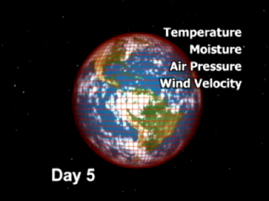Teachers' Domain - Digital Media for the Classroom and Professional Development
User: Preview

Source: ThinkTV
Climate scientists have used computer-based mathematical models to help them think about the climate system since the 1990s. Although these tools have made great advances over the years, and can now model many parts of past and future climates, climate models still have a long way to go in order to accurately simulate real-world climate conditions.
In order to make sense of the complex topic of scientific climate models, we need to define a few terms:
A system is an arrangement of interacting parts or subsystems that function as a complex whole. The interactions within systems like the climate system can be very complex, so we study systems by constructing simplified representations of them called models.
A model is a simplified representation of a system. A scientific model allows us to study and explain how a system or part of a system works. Because models are simpler than the systems they represent, models can help us understand the sometimes complex connections between parts of a system. Physical models, like a globe, are often designed to represent parts of a system, sometimes in a different scale. Conceptual models often begin as a sketch, description, or an analogy used to highlight the connections within a system, or how it works. Mathematical models, also called numerical models, are based on equations that show how each variable depends on the value of the other variables. These types of models usually include a way to input information, a way to experiment with the information, and a way to give us results.
Systems, and the complex interactions within these systems, are influenced by many variables. Because models cannot include all the variables, they are not complete or perfect representations. Even so, a model is a powerful tool that can represent the basic processes of the system, as we currently understand them, enabling researchers to evaluate what will happen to the system in the future.
The climate system is composed of and influenced by the hydrosphere (oceans, water cycle) the atmosphere, the cryosphere (ice sheets, glaciers, and permafrost), the biosphere (living things, including humans), and the geosphere (soil, sediments, and rocks).
Climate models are used to explore the interactions between two or more subsystems that play a role in generating climate, including: atmosphere, land surface, oceans, sea ice, aerosols, vegetation, atmospheric chemistry, solar radiation, and biogeochemical cycles (such as the carbon or nitrogen cycle).
Climate models do not predict a future climate; they project what climate may be like based on possible scenarios. Some climate scientists believe it will take 10 to 20 years of work to increase the ability of these models to accurately simulate climate conditions in detail.
Here are suggested ways to engage students with this video and with activities related to this topic.
 Loading Standards
Loading Standards